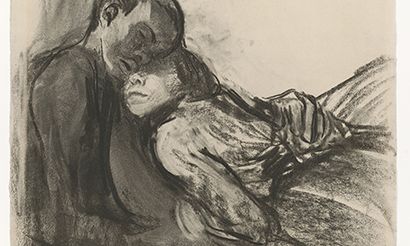Käthe Kollwitz’s Pair of Lovers, Nestling Together (1909-10), created during a period when the German artist was ‘frequently preoccupied with the theme of sexuality’ Photo: © Claudia Goldberg, Saša Fuis; © Käthe Kollwitz Museum Köln
If anyone is well placed to provide a survey of Käthe Kollwitz’s powerfully moving work, it is Dr Hannelore Fischer, the director of Cologne’s Käthe Kollwitz Museum for over 30 years until her retirement in March 2022. The date range embedded in the title might seem slightly eccentric—after all, Kollwitz was born in 1867 and died in 1945—yet the focus on the span of her career, rather than on the various tragedies of her biography, signals a subtle but important distinction.
Unquestionably, Kollwitz’s often harrowing depictions of social injustice invite an emotional response: faced with psychologically visceral works, combined with intimate biographical details revealed through her letters and diaries, it is easy to lose sight of the sheer technical brilliance of her output across a range of media. Fischer handles the challenge by dispensing with a biographical survey in her introduction and including a timeline at the end. Placing the introduction before the acknowledgements section signals again that this is not a straightforward chronological account of the artist’s life and work.
Instead, the main text unfolds thematically, starting with the first of two chapters on Kollwitz’ self-portraiture: a theme with which the book’s text also concludes, achieving a beautiful symmetry by allowing readers to reflect on how the artist saw herself—full of youthful optimism at the beginning while never losing the fierce determination “to have an effect on these times”—to the last.
If self-portraiture bookends this study, the chapters in between steer deftly through different types of approach. Some remain thematically focused on issues such as social critique, love scenes and nudes, departures, portraits, politics, posters, the war years, mothers and children, loss and mourning, while two others home in on the major early print cycles, A Weavers’ Revolt (1892-97) and The Peasants’ War (1902/03-08), and chapter four focuses specifically on the significance of Kollwitz’s time spent in Paris in 1901 and again in 1904.
Each chapter is prefaced with a short account by Fischer, followed by a truly glorious selection of full-colour plates that show how Kollwitz’s famously monochromatic work is in fact importantly nuanced by the various types of tinted paper on which she drew and printed her motifs. The materiality of Kollwitz’s images as art objects is largely well served here. Interspersed throughout each chapter are significant quotations from Kollwitz’s writings that help to illuminate the technical production of specific works and the artist’s intended effects.
An especially original contribution to Kollwitz scholarship is the chapter devoted to “Love Scenes and Nudes”. While most accounts in the English language tend to focus on the two early major print cycles (named above), the loss of her son Peter on the battlefields of the First World War, her turn to monumental sculpture in order to memorialise his and fellow soldiers’ sacrifice, grieving mothers and wives, and the hunger, poverty and destitution of working-class families, very few, if any, spend any time on the so-called “Sekreta” sheets of 1909-10. Depicting lovers in sensual and intimate embrace, as Fischer notes, they were created during a period when “Kollwitz was frequently preoccupied with the theme of sexuality” as witnessed in diary entries of the same date that record her erotic dreams.
The inclusion of a couple of these drawings in an introductory survey to Kollwitz’s oeuvre is testament to the assured grasp that informs Fischer’s well-balanced account of the artist’s immense achievements. This book is borne of a sustained career-long engagement by its author with the richly nuanced ideas, thoughts, intellectual and artistic traditions with which Kollwitz immersed herself in order to produce art that continues to inspire passion and admiration across the globe.
Hannelore Fischer (ed.), Käthe Kollwitz: A Survey of her works 1888-1942, Hirmer Verlag/Käthe Kollwitz Museum (Köln), 304pp, 259 colour illustrations, £39.95 (hb), published 28 April
• Dorothy Price is the professor of modern and contemporary art and critical race art history at the Courtauld Institute of Art, London and editor of Art History

